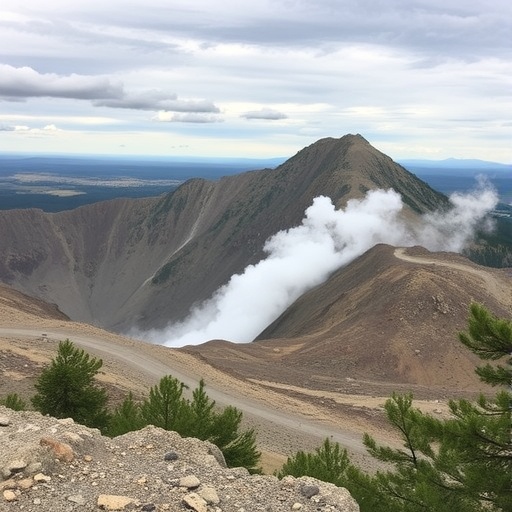Madison Myers, a distinguished volcanologist and associate professor at Montana State University’s Department of Earth Sciences, is redefining the intersection of scientific inquiry, education, and public outreach through her pioneering research on the Yellowstone supervolcano. Situated beneath one of America’s most iconic national parks, this volcanic system poses complex scientific questions that Myers approaches with rigorous fieldwork and innovative laboratory techniques that advance our understanding of volcanic processes and hazard assessment.
Her research fundamentally addresses the magmatic systems beneath Yellowstone, which have not erupted for approximately 70,000 years but continue to influence geothermal activity and local seismicity. Utilizing state-of-the-art analytical equipment funded by a National Science Foundation CAREER award, Myers probes the mineralogical and geochemical signatures found in volcanic deposits. These mineral records act as proxies, revealing the temporal evolution of magma bodies, their storage, ascent, and ultimately eruption triggers, much like dendrochronology demonstrates historical climatic conditions through tree rings.
At the core of Myers’ work lies the challenge of volcanic eruption forecasting—an inherently complex scientific problem that balances the interpretation of geophysical signals with probabilistic modeling. Yellowstone’s volcanic system demonstrates periods of relative quiescence punctuated by episodes of unrest, including seismic swarms and ground deformation. Myers emphasizes the necessity of multidisciplinary observational networks, such as the Yellowstone Volcano Observatory consortium, which integrates data from seismic arrays, GPS, gas emissions, and thermal monitoring to understand this volatile environment.
A critical component of her approach is effective communication of volcanic hazards to both scientific audiences and the public. Myers acknowledges the anxiety that often accompanies discussions of Yellowstone’s potential explosive power but advocates for transparent, evidence-based messaging that clarifies how modern monitoring technologies detect early warning signs. Her outreach extends to teaching strategies that cultivate students’ skills not only in volcanology but also in science communication, ensuring future generations can responsibly engage with complex geoscientific challenges.
Moreover, Myers’ laboratory—the MOnSTER lab—serves as a training ground for undergraduate researchers who engage directly with ongoing projects, including updating geologic maps and analyzing real-time data streams from Yellowstone. The recruitment for these competitive summer research experiences highlights the surge of student interest in Earth sciences despite nationwide declines in STEM enrollments. These programs foster hands-on learning and contribute critical data for national observatories, bridging academic research and practical volcanic hazard mitigation.
A notable achievement in her career was instrumental in Montana State University joining the Yellowstone Volcano Observatory in 2020. This partnership places MSU among nine leading institutions collaboratively monitoring regional volcanic activity across the United States, alongside observatories responsible for prolific volcanoes in Alaska, Hawaii, and the Cascade Range. Such collaborations harness distributed expertise and facilitate the sharing of large geophysical datasets critical for real-time analysis and hazard forecasting.
Myers’ research contributions extend beyond Yellowstone into broader volcanic systems worldwide, where her multidisciplinary and field-based methodologies set new standards. The Geological Society of America recognized these efforts by awarding her their Mineralogy, Geochemistry, Petrology, and Volcanology Division Early Career award, reflecting her impactful scholarship within the geosciences community.
Her lab’s utilization of petrographic and geochemical methods to dissect volcanic materials allows her team to reconstruct magma chamber processes and the physical conditions preceding eruptions. This capability informs models of eruptive behavior and contributes essential empirical data to hazard predictions. Myers integrates field observations, seismic activity, and petrology to develop comprehensive volcanic system models—providing a window into the deep Earth processes governing volcanic unrest.
Throughout her academic tenure, Myers has also played a pivotal role in promoting diversity and inclusion within STEM fields, earning nominations for awards dedicated to gender equity and mentoring. By fostering an inclusive research environment, she supports varied perspectives essential for innovative scientific discovery. Her engagement with students focuses on building confidence and scientific literacy, preparing them to contribute meaningfully to geoscience research and public education.
Strategically located amid some of the oldest and youngest rocks on Earth, MSU offers Myers and her students a unique natural laboratory that spans billions to thousands of years in geologic time. This diversity not only enriches her research opportunities but also captures student imagination, encouraging a tactile connection to scientific concepts learned in classrooms. The physical geology curriculum at MSU, buoyed by active research, attracts a robust cohort of students driven by curiosity and a desire to impact Earth science understanding.
In a broader context, Myers’ work embodies the growing trend in Earth sciences that links fundamental research to societal needs. Accurate volcanic hazard assessment informs emergency preparedness protocols, risks to communities, and broader environmental impacts. Scientific advances achieved through her leadership and mentorship underscore the critical role academia plays in addressing timely global challenges posed by natural hazards.
As public interest in Yellowstone’s volcanic activity intensifies periodically, Myers’ expertise provides clarity and grounded perspectives. By combining rigorous data collection, analytical expertise, and community engagement, she facilitates a nuanced narrative about volcanoes that balances caution with scientific confidence. Her advancement of knowledge and dedication to teaching enrich both the scientific community and public discourse on volcanic phenomena.
Her contributions have proven integral to the national framework for volcano monitoring, situating her as a leading figure in volcanology. The integration of cutting-edge laboratory techniques with extensive field monitoring exemplifies the future of geoscience research. Myers’ work continues to inspire aspiring scientists and emphasizes the profound importance of sustained investment in multidisciplinary Earth science research and education.
Subject of Research: Volcanology, magma dynamics, volcanic hazard assessment, Yellowstone supervolcano monitoring
Article Title: Montana State University Volcanologist Madison Myers Earns Prestigious Early Career Award for Groundbreaking Yellowstone Research
News Publication Date: September 25, 2025
Web References:
– https://www.montana.edu/earthsciences/directory/2139971/madison-myers
– https://community.geosociety.org/mgpvdivision/awards/earlycareer
– https://www.montana.edu/news/20217/msu-becomes-member-of-yellowstone-volcano-observatory
– https://www.montana.edu/news/21241/madison-myers-earns-nsf-career-grant-for-yellowstone-volcano-research
– https://www.usgs.gov/observatories/yvo/news/how-take-a-volcanos-temperature
Image Credits: MSU photo by Colter Peterson
Keywords: Volcanology, Geology, Earth sciences, Magma dynamics, Yellowstone supervolcano, Volcanic hazard, Mineralogy, Geochemistry, Petrology




